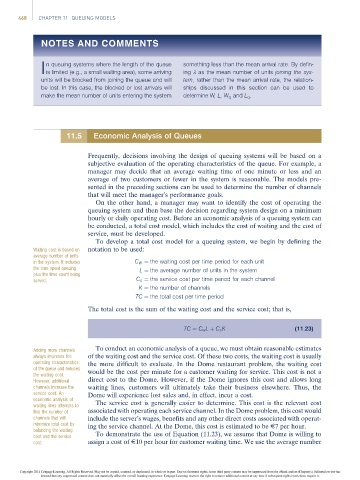Page 488 -
P. 488
468 CHAPTER 11 QUEUING MODELS
NOTES AND COMMENTS
n queuing systems where the length of the queue something less than the mean arrival rate. By defin-
I is limited (e.g., a small waiting area), some arriving ing l as the mean number of units joining the sys-
units will be blocked from joining the queue and will tem, rather than the mean arrival rate, the relation-
be lost. In this case, the blocked or lost arrivals will ships discussed in this section can be used to
make the mean number of units entering the system determine W, L, W q and L q .
11.5 Economic Analysis of Queues
Frequently, decisions involving the design of queuing systems will be based on a
subjective evaluation of the operating characteristics of the queue. For example, a
manager may decide that an average waiting time of one minute or less and an
average of two customers or fewer in the system is reasonable. The models pre-
sented in the preceding sections can be used to determine the number of channels
that will meet the manager’s performance goals.
On the other hand, a manager may want to identify the cost of operating the
queuing system and then base the decision regarding system design on a minimum
hourly or daily operating cost. Before an economic analysis of a queuing system can
be conducted, a total cost model, which includes the cost of waiting and the cost of
service, must be developed.
To develop a total cost model for a queuing system, we begin by defining the
Waiting cost is based on notation to be used:
average number of units
in the system. It includes C W ¼ the waiting cost per time period for each unit
the time spent queuing L ¼ the average number of units in the system
plus the time spent being
served. C s ¼ the service cost per time period for each channel
K ¼ the number of channels
TC ¼ the total cost per time period
The total cost is the sum of the waiting cost and the service cost; that is,
TC ¼ C w L þ C s K (11:23)
Adding more channels To conduct an economic analysis of a queue, we must obtain reasonable estimates
always improves the of the waiting cost and the service cost. Of these two costs, the waiting cost is usually
operating characteristics the more difficult to evaluate. In the Dome restaurant problem, the waiting cost
of the queue and reduces
the waiting cost. would be the cost per minute for a customer waiting for service. This cost is not a
However, additional direct cost to the Dome. However, if the Dome ignores this cost and allows long
channels increase the waiting lines, customers will ultimately take their business elsewhere. Thus, the
service cost. An Dome will experience lost sales and, in effect, incur a cost.
economic analysis of
waiting lines attempts to The service cost is generally easier to determine. This cost is the relevant cost
find the number of associated with operating each service channel. In the Dome problem, this cost would
channels that will include the server’s wages, benefits and any other direct costs associated with operat-
minimize total cost by ing the service channel. At the Dome, this cost is estimated to be E7 per hour.
balancing the waiting
cost and the service To demonstrate the use of Equation (11.23), we assume that Dome is willing to
cost. assign a cost of E10 per hour for customer waiting time. We use the average number
Copyright 2014 Cengage Learning. All Rights Reserved. May not be copied, scanned, or duplicated, in whole or in part. Due to electronic rights, some third party content may be suppressed from the eBook and/or eChapter(s). Editorial review has
deemed that any suppressed content does not materially affect the overall learning experience. Cengage Learning reserves the right to remove additional content at any time if subsequent rights restrictions require it.

